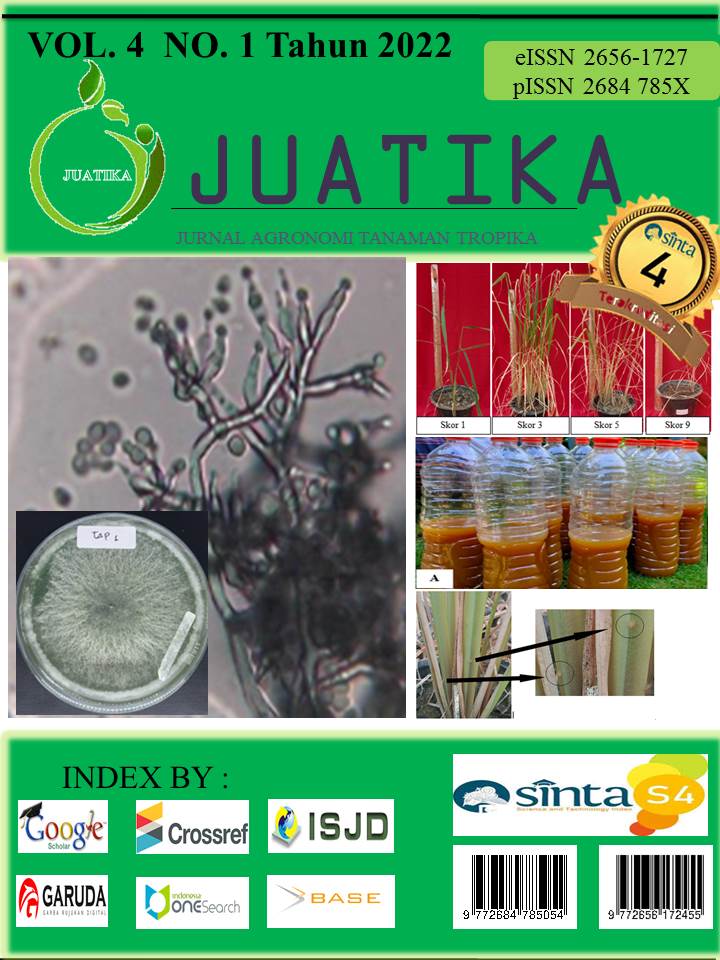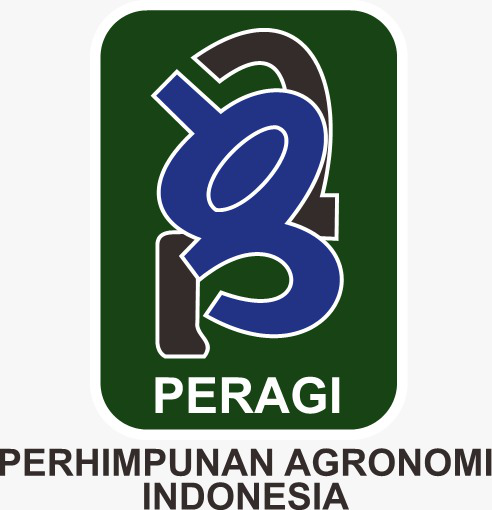The Effect Of Paclobutrazol Concentration And Types Of Organic Liquid Fertilizer On The Growth And Production Of Tomató (Solanum Lycopersicum L.)
Abstract
Tomatoes are a horticultural commodity that has the potential to be developed because it has high economic value and great export potential. The increase in tomato needs is often not offset by increased production so that Indonesia has not been able to meet the needs of national tomatoes, in addition to the issue of food quantity has shifted to the issue of food quality and food safety by using natural ingredients. This study aims to determine the concentration of paclobutrazol that can simulate reproductive growth and the best type of liquid organic fertilizer in replacing chemical fertilizers to increase the growth and yield of tomato plants. The combination of paclobutrazol concentration and liquid organic fertilizer is expected to increase tomato yield. This study used a plot design divided into two factors, namely the concentration of paclobutrazol and the type of liquid organic fertilizer with 16 combinations of treatments repeated 3 times. The first factor is the concentration of paclobutrazol with 4 levels, namely 0 ppm, 100 ppm, 150 ppm, and 200 ppm. The second factor is the type of liquid organic fertilizer with 4 levels of NPK fertilizer 25 grams / plant, water hyacinth 150 ml / plant, banana peel 150 ml/plant, and NASA 150 ml / plant. The results showed interactions in the total number of fruits per plant, the total fresh weight of fruit per plant, and the percentage of fruit sets. Paclobutrazol concentration of 100 ppm and the type of liquid organic fertilizer banana skin, 150 ml/ plant showed the highest yield in the number of fruits per harvest period (12 pieces), total fruit count per plant (63 pieces), fresh weight of fruit per harvest period (436.63 grams), total fresh fruit weight per plant (1815.80 grams), and percentage of fruit set (76.83%).
Downloads
References
Ardigusa, Y., & Sukma, D. (2015). Pengaruh Paclobutrazol terhadap Pertumbuhan dan Perkembangan Tanaman Sanseviera ( Sanseviera trifasciata Laurentii ). J. Hort. Indonesia, 6(1), 45–53.
Badan Pusat Statistik Republik Indonesia. (2018). Statistik Tanaman Sayuran dan Buah-buahan Semusim Indonesia (Subdirektorat Statistik Hortikultura (ed.); 1st ed.). Badan Pusat Statistik Republik Indonesia.
Ermawati, W. O., Wahyuni, S., & Rejeki, S. (2016). Kajian Pemanfaatan Limbah Kulit Pisang Raja (Musa Paradisiaca Var Raja) Dalam Pembuatan Es Krim. J. Sains dan Teknologi Pangan, 1(1), 67–72.
Fitriani. (2017). Respon Anatomi Batang Tanaman Padi Hitam (Oryza sativa L “Cempo Ireng”) dengan Aplikasi Paklobutrazol dan Pupuk Organik Cair. Journal of Islamic Science and Technology, 3(1), 67–78.
Harpitaningrum, P., Sungkawa, I., & Wahyuni, S. (2014). Pengaruh Konsentrasi Pacloburazol Terhadap Pertumbuhan dan Hasil Tanaman Mentimun (Cucumis sativus L.) Kultivar Venus. Jurnal Agrijati, 25(1), 1–17.
Jasmine, M., Ginting, J., & Siagian, B. (2014). Respons Pertumbuhan dan Produksi Semangka (Citrullus vulgaris Schard.) Terhadap Konsentrasi Paclobutrazol dan Dosis Pupuk NPK. Jurnal Online Agroteknologi, 2(3), 967–974.
Khodijah, N. S., Kusmiadi, R., Belitung, U. B., Semangat, G., Balunijuk, D., Merawang, K., & Bangka, K. (2021). Growth Of Lettuce (Lactuca sativa) Hydroponically In Simple Wick System On Various Types Of Nutrient. JUATIKA. 3(2). 180-186.
Ibrahim & Tanaiyo. (2018). Response Of Mustrad Crop (Brasisca juncea L) On Liquid Organic Fertilizer From The Peel And Hump Of Banana,Jurnal Agropolitan, 5(1), 63–69.
Laginda, Y. S. (2017). Aplikasi Pupuk Organik Cair Berbahan Dasar Batang Pisang Terhadap Pertumbuhan Dan Produksi Tanaman Tomat (Lycopersicum esculentum Mill.). Jurnal Galung Tropika, 6(2), 81–92.
Marshel, E., Bangun, M. K., & Putri, L. A. P. (2015). Pengaruh Waktu dan Konsentrasi Paclobutrazol Terhadap Pertumbuhan Bunga Matahari (Hellianthus annuus L.). Jurnal Online Agroteknologi, 3(3), 929–937.
Nasution, F. J., Mawarni, L., & Meiriani. (2014). Aplikasi Pupuk Organik Padat Dan Cair Dari Kulit Pisang Kepok Untuk Pertumbuhan Dan Produksi Sawi (Brassica juncea L.). Jurnal Online Agroteknologi, 2(3), 1029–1037.
Neli, S., Jannah, N., & Rahmi, A. (2016). Pengaruh Pupuk Organik Cair Nasa dan Zat Pengatur Tumbuh Ratu Biogen Terhadap Pertumbuhan dan Hasil Tanaman Terung (Solanum melongena L.) Varietas Antaboga-1. Jurnal AGRIFOR, XV(2), 297–308.
Purba, J. H., Srilaba, N., Wahyuni, P. S., & Wahyuda, P. B. (2021). Response Of Papaya (Carica papaya L .) Seeds Growth To The Gibberellin (GA3) and Cow Biourine. JUATIKA, 3(2), 148–158.
Sambeka, F., Runtunuwu, S. D., & X Rogi, J. E. (2012). Efektifitas Waktu Pemberian dan Konsentrasi Paclobutrazol Terhadap Pertumbuhan dan Hasil Kentang (Solanum tuberosum L.) Varietas Supejohn. Eugenia, 18(2), 126–134.
Nazibah, M.S.S., Karno & Lukiwati, D.R. (2018). Respon pertumbuhan dan perkembangan tanaman tomat (Solanum lycopersicum) terhadap paklobutrazol dan komposisi media tanam. J. Agro Complex, 2(3), 199–205.
Soumya, P. R., Kumar, P., & Pal, M. (2017). Paclobutrazol : a novel plant growth regulator and multi-stress ameliorant. Indian Journal of Plant Physiology, 22(3), 267–278.
Sumadi, Suminar, E., Murgayanti, & Nuraini, A. (2015). Pengaruh pemberian zat retardan terhadap pertumbuhan dan hasil ubi pada dua kultivar kentang ( Solanum tuberosum L .) di dataran medium. Jurnal Kultivasi, 14(2), 49–54.
Syaputra, E., Nurbaiti, & Yoseva, S. (2017). Pertumbuhan dan Produksi Tanaman Tomat (Lycopersicum esculentum Mill.) dengan Pemangkasan Satu Cabang Utama. JOM FAPERTA, 4(1), 1–11.
Tuapattinaya, P., & Tutupoly, F. (2014). Pemberian Pupuk Kulit Pisang Raja (Musa sapientum) Terhadap Pertumbuhan dan Produksi Tanaman Cabai Rawit (Capsicum frutescens L.). Biopendix: Jurnal Biologi, Pendidikan Dan Terapan, 1(1), 13–21.
Copyright (c) 2022 Adila Sukma Jayanti, Agus sulistyono, Didik Utomo Pribadi

This work is licensed under a Creative Commons Attribution 4.0 International License.
Authors who publish with Jurnal Agronomi Tanaman Tropika (JUATIKA) agree to the following terms:
Authors retain copyright and grant the Jurnal Agronomi Tanaman Tropika (JUATIKA) right of first publication with the work simultaneously licensed under a Creative Commons Attribution License (CC BY 4.0) that allows others to share (copy and redistribute the material in any medium or format) and adapt (remix, transform, and build upon the material for any purpose, even commercially) with an acknowledgment of the work's authorship and initial publication in Jurnal Agronomi Tanaman Tropika (JUATIKA).
Authors are able to enter into separate, additional contractual arrangements for the non-exclusive distribution of the journal's published version of the work (e.g., post it to an institutional repository or publish it in a book), with an acknowledgment of its initial publication in Jurnal Agronomi Tanaman Tropika (JUATIKA). Authors are permitted and encouraged to post their work online (e.g., in institutional repositories or on their website) prior to and during the submission process, as it can lead to productive exchanges, as well as earlier and greater citation of published work.







 More Information
More Information



